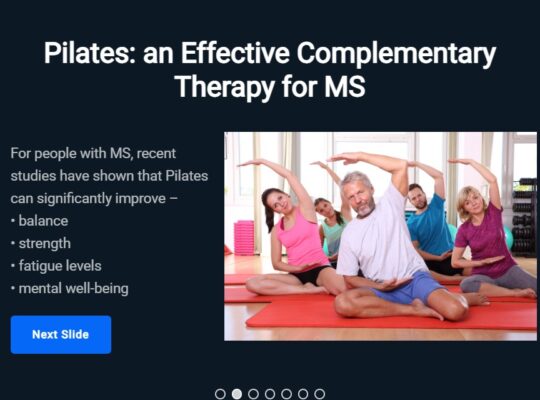![]() Watch the slideshow about why Pilates is an effective therapy for people with MS.
Watch the slideshow about why Pilates is an effective therapy for people with MS.
Preparing for Your Pilates Routine
- Choose the right environment: A quiet, distraction-free space.
- Wear comfortable clothing: Allows for unrestricted movement.
- Use supportive equipment: Consider a yoga mat, stability ball, and resistance bands.
- Start with short sessions: 10–15 minutes per session, gradually increasing to 30–45 minutes.
- Practice regularly: At least 2–3 times per week for best results.
Beginner-Friendly Pilates Exercises for MS
1). Seated Breathing and Core Engagement
- Sit upright in a chair.
- Inhale deeply through the nose, expanding the belly.
- Exhale slowly through the mouth, engaging the core.
- Repeat 5–10 times.
✅ Benefits: Improves lung capacity, reduces stress, and enhances core activation.
2). Pelvic Tilt (Supine on Mat)
- Lie on your back with knees bent, feet flat on the floor.
- Gently tilt the pelvis upward, engaging the abdominal muscles.
- Hold for 3 seconds, then relax.
- Repeat 10 times.
✅ Benefits: Strengthens core stability, reduces lower back pain, and improves posture.
3). Seated Spinal Twist
- Sit in a chair with feet flat on the floor.
- Place one hand on the opposite knee and gently twist the torso.
- Hold for 5 seconds, then switch sides.
- Repeat 5 times per side.
✅ Benefits: Improves spinal mobility and relieves tension.
4). Leg Circles (Supine on Mat)
- Lie on your back with one leg extended and the other raised.
- Make small circles with the raised leg.
- Perform 5 circles clockwise and 5 counterclockwise, then switch legs.
✅ Benefits: Enhances hip mobility, balance, and lower-body strength.
5). Standing Side Leg Lifts
- Stand tall, using a wall or chair for support.
- Lift one leg to the side, keeping it straight.
- Hold for 2 seconds, then lower.
- Perform 10 reps per leg.
✅ Benefits: Strengthens hip stabilizers and improves balance.
6). Seated Shoulder Rolls
- Sit upright and roll shoulders forward and backward in a slow, controlled motion.
- Repeat 10 times.
✅ Benefits: Relieves shoulder tension and improves upper-body mobility.
Making Pilates a Sustainable Habit
- Set realistic goals: Start with small, achievable milestones.
- Listen to your body: Modify exercises based on comfort level.
- Stay consistent: Regular practice yields the best results.
- Join a class: Consider online or in-person Pilates sessions designed for MS.
- Track progress: Keep a journal of energy levels, balance, and strength improvements.
Conclusion
Pilates is a safe, adaptable, and effective exercise method for improving balance, strength, mobility, and mental well-being in individuals with MS.
Research confirms its benefits in reducing fatigue, enhancing muscle coordination, and supporting emotional resilience. By integrating tailored Pilates exercises into daily routines, MS patients can experience improved quality of life and greater independence.
Would you like to start your Pilates journey today? Try these beginner-friendly exercises and feel the difference!






